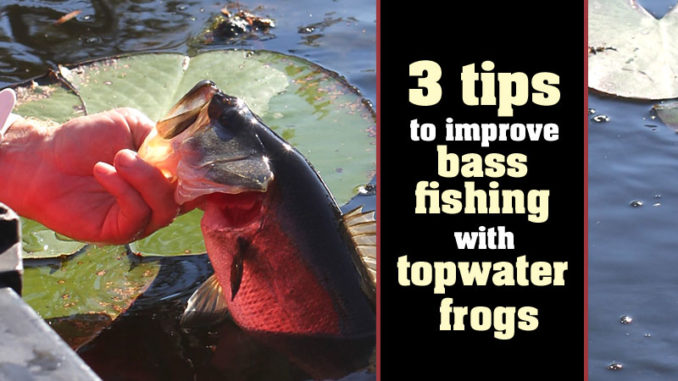
Hollow-body frogs are great lures, but even better with these tips
This time of year, a good chunk of many bodies of fish-holding water are covered in surface weeds. Lily pads and alligator grass are two of the main surface plants that can make bass fishing difficult. Any lure with a treble hook is useless in these circumstances, and even weedless-rigged soft plastic worms foul easily on the retrieve. This water is ripe for bass though, so anglers don’t want to pass up a shot at catching fish here. Thanks to a certain lure, they don’t have to.
The best lure option—and perhaps the only lure option—for this situation is the hollow-body frog. These frogs are designed to ride on top of the vegetation, and the hooks point up and back into the body, keeping them from snagging onto the weeds. It is, by fishing lure standards, a super weedless option, and almost anyone who has retrieved one across floating vegetation has stories of massive water explosions and lures getting knocked 3-feet into the air. Unfortunately, many of those same anglers complain that they’ve never been able to consistently land the bass that have been sending their frogs skyward. Three tips from a few fans of hollow-body frogs can help those anglers increase their hookup ratios when using these lures.
One of the biggest tips comes from SCDNR biologist Scott Lamprecht, who has a unique perspective on fishing. He knows the biology behind what makes fish bite, and he also loves to fish as a hobby. He said anglers fishing hollow-body frogs should follow the 80-20 rule. “Eighty percent of the bass you catch in heavily weeded water will come in a 20-foot area,” he said. That 20-foot area, according to Lamprecht will come in the 10-foot edge of the weeds and the 10-feet of clear water that borders the weeds.

“You could also call it the 10-10 rule, because the majority of your catches will come in that 10 feet of lily pads and the 10 feet just beyond the lily pads. Many anglers give up on their retrieve as soon as their frog clears the lily pads, but that’s a mistake. A lot of bass will follow the frog out, staying underwater and then hitting the lure in the clearing,” said Lamprecht.
Brett Collins from Ridgeway, SC catches plenty of bass on Lake Wateree using hollow-body frogs in the grass. His tip is to use heavy-duty line. “I use at least 65-pound braided line when fishing this way, and that is not overkill. You are going to hook a big largemouth one day, and even though it certainly won’t weight 65-pounds, it will wrap you around every bit of vegetation it can, and the weight of the slop you reel in along with that bass will break some strong line. This is no place for 15-pound test line,” said Collins.
The third tip comes from Daniel Sbrocco of Jacksonville, NC, who said anglers should not shy away from casting into weedy areas that you know are too thick for a bass to eat through. “I love to find a creek that is just choked up with weed mats so thick that the tops aren’t even wet. I’ve told myself a million times, “there’s no way a bass can see the frog through that, much less eat it,” he said. “And every time I tell myself that, I make a cast there. Sometimes, nothing, but more often than you’d think, BAM! one comes smashing through the grass,” said Sbrocco, adding that these areas are usually where the biggest bass live. “Most of these fish have probably never seen a fishing lure because nobody will cast to weeds that thick.”




Be the first to comment